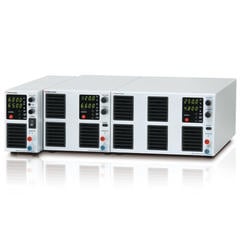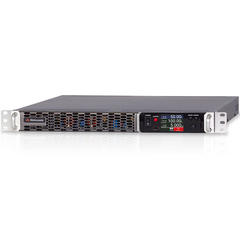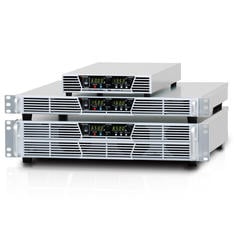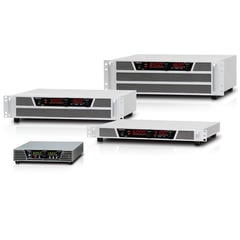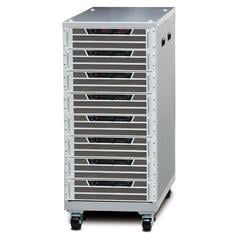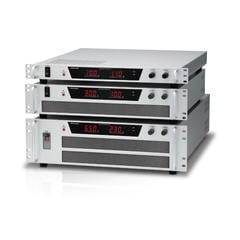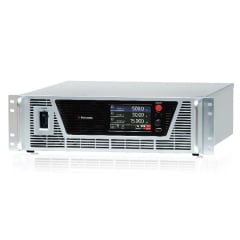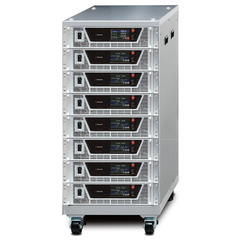What is the RF amplifier?
An RF amplifier is a radio frequency amplifier that can supply current at high frequencies. Also called RF power amplifier, RF power supply, high frequency power supply, microwave power amplifier, etc.. Mainly used for plasma generation used in semiconductor manufacturing processes. This plasma is used to perform surface treatment and deposition of semiconductors such as etching and sputtering.
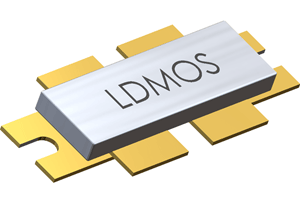
What is the frequency of the RF amplifier?
RF amplifiers generate frequencies on the order of kHz to GHz. However, for non-broadcasting applications, the Radio Frequency (Radio spectrum) Law limits the frequency to 13.56 MHz or 2.45 GHz (the frequency used in microwave ovens). In addition, notification and permission may be required for use.
How does the RF amplifier work?
An RF amplifier's basic components include an oscillator, a DC power supply, transistors, and a matching circuit.
Oscillator
The oscillator generates the frequency of the RF signal. The 13.56 MHz frequency is mainly used in industrial applications.
DC power supply
The DC power supply provides the bias voltage and current to operate the transistors. Variable DC power supplies up to about 100 V are used. The current or power varies from a few hundred watts to several kilowatts or tens of kilowatts, depending on the application.
Transistor
RF power amplifiers typically use transistors as the amplifying element.
The following is a list of commonly used transistor types.
LDMOS (Lateral Diffusion Metal Oxide Semiconductor)
Advantages: High power handling capability and efficiency, suitable for RF applications. It combines the advantages of MOSFET and BJT.
Function: Often used in high-power RF amplifiers and can switch effectively at high frequencies.
- LDMOS device manufacturers
- Ampleon: https://www.ampleon.com/
- NXP Semiconductors: https://www.nxp.com/
- Infineon Technologies: https://www.infineon.com/
- STMicroelectronics: https://www.st.com/
- Integra Technologies: https://www.integratech.com/
- MACOM: https://www.macom.com/
- Wolfspeed (formerly Cree): https://www.wolfspeed.com/
- Qorvo: https://www.qorvo.com/
- Analog Devices: https://www.analog.com/
- Microchip Technology: https://www.microchip.com/
MOSFET (Metal Oxide Semiconductor Field Effect Transistor):
Advantages: fast switching, excellent thermal stability, high efficiency. Often used in applications requiring high-speed switching.
Function: Fast on/off, controls current flow, effectively converts DC voltage to high-frequency AC waveforms.
GaN (Gallium Nitride) Transistors
Advantages: excellent efficiency, high breakdown voltage, very fast switching speed. These properties have made GaN increasingly popular in high-frequency applications.
Function: GaN devices used in state-of-the-art power supplies can support high frequencies (up to several GHz) and provide higher power densities than traditional silicon-based devices.
Matching network
The matching network is the impedance matching circuit with the load.
- Operating principles
- Input stage: RF signal is applied to the input of the transistor (gate of LDMOS/MOSFET/GaN).
- Amplification: Transistors amplify input signals by converting DC power from the power supply into RF power.
- Output stage: The amplified signal is sent to the output (drain of LDMOS/MOSFET/GaN).
- Matching network: The input/output matching net object optimizes optimal power transmission and impedance matching with the load.
- Bias: The DC bias circuit sets the operating point of the transistor for proper amplification.
- Efficiency
- Recent RF amplifiers have improved power conversion efficiency and energy conservation through the use of high-efficiency RF amplifiers, with some reaching power conversion efficiencies of 90% or more. Improved power conversion efficiency has reduced heat generation and the burden of cooling, resulting in lighter, more efficient models.
The built-in fast auto-matching feature allows for quick response to load variations, maintaining efficiency by minimizing reflected power, and dynamic power management, which adjusts the DC supply voltage based on output power requirements, can significantly improve efficiency.
- Issue
- • Heat dissipation: High power operation generates considerable heat and requires effective thermal management.
- • Linearity: Maintaining linearity while achieving high efficiency is an important issue, especially for modern modulation schemes.
- • Stability: It is very important to prevent unwanted vibrations and ensure stable operation under various conditions.
- • Harmonic Suppression: Harmonic components of the RF signal must be suppressed and kept below -35 dB.
- • Improved reliability: High reliability is required for use in critical processes such as semiconductor manufacturing equipment.
To address these issues, the high output power, efficiency, and linearity required for RF power supplies are continuously being improved by optimizing RF circuit design, employing high-performance semiconductor devices, and utilizing digital control technology. In addition, by feeding our experience and know-how as an equipment manufacturer back into the design process, we are developing highly practical RF power supplies.
What are the applications of RF amplifiers?
RF amplifiers are used in the fields of science, industry, telecommunications, and medicine.
- Plasma generator for semiconductor manufacturing equipment
- Magnetic resonance imaging (MRI systems)
- CO2 lasers
- Industrial heating, welding, and defrosting
- Synchrotron (Particle accelerators)
- Avionics radar, Power amplifiers for L-band and S-band radar, UHF radar
- Broadcast
- Power amplifier for mobile base stations
- FM & TV broadcasting
- HF & VHF communication
- Keywords:
-
- RF amplifier
- RF power amplifier
- high-frequency power supply
- microwave power amplifier
- Plasma
- LDMOS
- Langmuir probe




